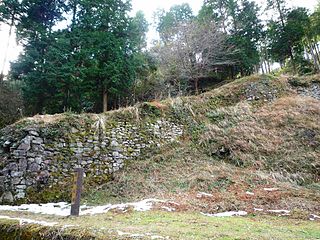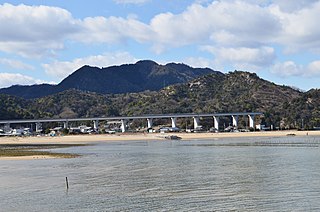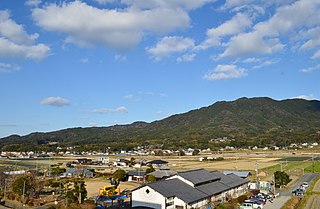
Ki castle was an ancient kōgoishi type castle (also known as a Korean-style fortresses in Japan located in the city of Sōja, Okayama Prefecture, Japan. Its ruins have been protected as a National Historic Site since 1986. Portions of the castle were reconstructed in the early 2000s.
Kōgoishi are earthenwork structures, on a stone foundation, constructed in Japan during the Asuka period, particularly in areas around Fukuoka, on the island of Kyūshū. The name "kōgoishi" means "stones of divine protection," a name given them by the Meiji period archaeologist Tsuboi Shōgorō, who conjectured that they served as spiritual or practical protection for sacred sites.

Chikugo Province was a province of Japan in the area of northern Kyūshū, corresponding to part of southwestern Fukuoka Prefecture. Chikugo bordered on Higo and Chikugo to the southeast, and Chikuzen to the north and east, Bungo to the east and Hizen to the west. Its abbreviated form name was Chikushū (筑州), although it was also called Chikuin (筑陰). In terms of the Gokishichidō system, Chikugo was one of the provinces of the Saikaidō circuit. Under the Engishiki classification system, Chikugo was ranked as one of the "superior countries" (上国) in terms of importance, and one of the "far countries" (遠国) in terms of distance from the capital.

Ōno Castle was an ancient castle (also known as a Korean-style fortresses in Japan straddling the border of the cities of Ōnojō and Dazaifu, and the town of Umi, Fukuoka Prefecture Japan. Its ruins have been protected as a National Historic Site since 1932, and raised to a Special Historic Site since 1953 with the area under protection expanded in 2012. The name of Ōnojō City comes from this castle; however, approximately 80% of the castle area is within the boundaries of Umi Town.

Mizuki Castle was an ancient castle (also known as a Korean-style fortresses in Japan straddling the border of the cities of Ōnojō, Dazaifu, and Kasuga, Fukuoka Prefecture Japan. Its ruins have been protected as a National Historic Site since 1921, and raised to a Special National Historic Site since 1953 with the area under protection expanded in 2013.

Kiyama was an ancient castle (also known as a Korean-style fortresses in Japan located in the city of Sakaide, Kagawa, Japan, and extending partly into the neighboring city of Marugame. Its ruins have been protected as a National Historic Site since 1951. It is also known as Shiroyama Castle or Sanuki-Shiroyama Castle.

Kikuchi Castle was an ancient castle (also known as a Korean-style fortresses in Japan in the city of Kikuchi, Kumamoto Prefecture Japan. Its ruins have been protected as a National Historic Site since 2004.

Kii Castle was an ancient castle (also known as a Korean-style fortresses in Japan straddling the border between the city of Chikushino, Fukuoka and the town of Kiyama, Saga Prefecture Japan. Its ruins have been protected as a National Historic Site since 1937, and raised to a Special Historic Site since 1954.

Einōsan Castle was an ancient castle (also known as a Korean-style fortresses in Japan located in the city of Saijō, Ehime, Japan. Its ruins have been protected as a National Historic Site since 2005 with the area under protection expanded in 2007.

Iwakisan Kōgoishi (石城山神籠石) was an ancient castle (also known as a Korean-style fortresses in Japan located in the city of Hikari, Yamaguchi Prefecture, in the San'yō region of Japan. Its ruins have been protected as a National Historic Site since 1951.

Zoyama kōgoshi was an ancient castle (also known as a Korean-style fortress located in the Ōkusa, Setaka-chō neighborhood of the city of Kōge, Chikujō District, Fukuoka Prefecture Japan. Its ruins have been protected as a National Historic Site since 1953, with the area under protection expanded in 1977.
Tōbarusan Castle was an ancient castle (also known as a Korean-style fortresses in Japan located in the town of Kōge, Chikujō District, Fukuoka Prefecture Japan. Its ruins have been protected as a National Historic Site since 2005.

Goshogatani Kōgoishi (御所ヶ谷神籠石) was an ancient castle (also known as a Korean-style fortresses in Japan straddling the border between the Katsuyama Okubo townships of Miyako and the Tsuzumi neighborhood of the city of Yukuhashi, Fukuoka Prefecture Japan. Its ruins have been protected as a National Historic Site since 1953, with the area under protetcion expanded in 1998.
Hagi Kōgoishi (杷木神籠石) was an ancient castle (also known as a Korean-style fortresses in Japan located in the Hakihosaka and Hakihayashida neighborhoods of the city of Asakura, Fukuoka Prefecture Japan. Its ruins have been protected as a National Historic Site since 1972.
Ashikisan Castle was an ancient castle (also known as a Korean-style fortresses in Japan located in the Hakiho Ashiki neighborhood of the city of Chikushino, Fukuoka Prefecture Japan. Its ruins have been protected as a National Historic Site since 2011.

Kagenouma Kōgoishi (鹿毛馬神籠石) was an ancient castle (also known as a Korean-style fortresses in Japan located in the Kageuma neighborhood of the city of Iizuka, Fukuoka Prefecture Japan. Its ruins have been protected as a National Historic Site since 1945, with the area under protection expanded in 2002.

Ito Castle was an ancient castle (also known as a Korean-style fortresses in Japan located in the city of Itoshima, Fukuoka Prefecture Japan. Its ruins have been protected as a National Historic Site since 1938, with the area under protection expanded in 1944 and in 2007.

Raizan Kōgoishi (雷山神籠石) was an ancient castle (also known as a Korean-style fortresses in Japan located in the city of Itoshima, Fukuoka Prefecture Japan. Its ruins have been protected as a National Historic Site since 1932.

Obukumayama Kōgoishi (帯隈山神籠石) was an ancient Korean-style fortress located in the Kuboizumimachi neighborhood of Saga, Saga Prefecture, Japan. Its ruins have been protected as a National Historic Site since 1951.

Otsuboyama Kōgoishi (おつぼ山神籠石) was an ancient Korean-style fortress located in the Tachibana neighborhood of the city of Takeo, Saga Prefecture, Japan. Its ruins have been protected as a National Historic Site since 1966.



















